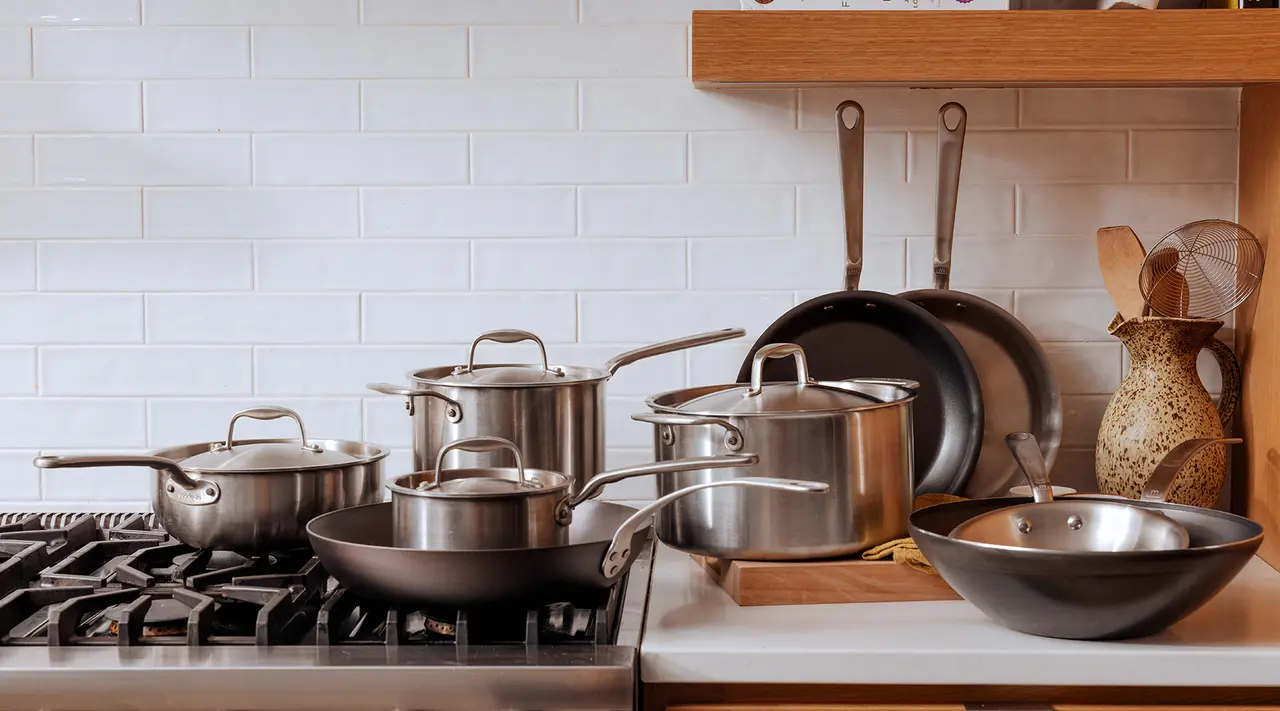Feeling overwhelmed with all the available options?
Here’s a comprehensive breakdown of the different types of cookware, their benefits, and downfalls.
Whether you’re a newlywed on a registry rampage or a happy homemaker who’s finally renovating their kitchen, purchasing cookware is a major milestone. Sets run upwards of thousands of dollars and can last decades assuming you opt for quality over affordability.
Before you grab the first box screaming your name from the shelf, check out the following ‘must-know’ tips for buying cookware. Once you have a handle on each material type, its advantages, and shortcomings, you’ll know exactly the construction that’s right for you and your cooking style.
But first, let’s revisit what the typical set comes with and how each piece offers cooking versatility. Most of the time, cookware advertised as a ’14-piece set,’ for instance, will only come with 7 or 8 actual pots and pans once you account for lids. So stay on the lookout for the following staples.
What comes in most cookware sets?
An extensive set will include the following pots and pans in varying sizes:
Frying pan – Also known as a skillet, the frying pan features a flat bottom and slightly rounded walls, making it perfect for cooking with oil, sauces and other liquid agents. It’s also ideal for quick searing or grilling on the stovetop.
Sauté pan – Similar to the frying pan, a sauté pan is designed to accommodate movement. Flat walls, a flat bottom, and a form-fitting lid let you stir, shift and shake things up without fear of spillage.
Sauce pan – Despite their straightforward name, saucepans are actually quite versatile. Use this lidded staple for simmering soups, whisking gravies, reheating sides, and more.
Stock pot – For recipes calling for large volumes of water or broth, the stock pot proves the perfect fit.
To be a master chef—which material works best?
There are endless styles of cookware construction, each with their own benefits and downfalls. Focusing on the home chef, here’s a brief breakdown of today’s most popular styles. Consider the level of maintenance you’re willing to put up with as well as the general strengths and weaknesses associated with each cookware material.
Stainless steel – Sleek, beautiful, durable and nonreactive, stainless steel cookware is exceedingly convenient. It’s relatively easy to clean, complements nearly any style of décor and won’t impact food’s flavor like other reactive metal varieties.
On the downside? Stainless steel gets HOT. If you're used to cooking with cast, you're used to cranking up the heat. With stainless steel cookware, heat control is vital. You’ll need to practice a “low and slow” cooking mentally to ensure that you don’t burn your food or make a mess in your pans.
Cast iron – A fabulous farmhouse option, cast iron is quaint, classic, versatile and hard-wearing. Pans tend to be heavy but resist warping and scratching and can safely go in the oven. They also conduct heat very easily, offer non stick convenience and can be seasoned over time for flavor-infusing effect.
What’s not to like? Cast iron proves rather bulky, and in order to season pans properly, there’s a lot of maintenance involved.
Ceramic – This variety has experienced rising popularity in recent years as chefs seek cooking flexibility and low maintenance. Ceramic withstands extreme temperatures and conditions, performing seamlessly whether it’s inside the oven, atop a hot stove, spinning in the microwave or store in the refrigerator. Choose from a variety of vibrant colors.
What’s to worry about? In general, ceramic is durable but prone to cracking and complete destruction if dropped. Sets are also on the heavier side and may discolor your countertops upon rough contact.
Copper – Have a need for speed in the kitchen? Copper conducts heat fast, distributing and maintaining balanced temperatures quite consistently. This makes it advantageous if you braise meats, brown poultry or cook sauces often. Its chic metallic exterior is also oh-so-trendy.
Does pretty have problems? Yes. Copper is typically expensive, dents easily, may transfer a slight metal taste and requires tedious polishing to ensure it maintains its stunning color.
Carbon steel – A favorite of many professional chefs, carbon steel is a lesser-known cookware style boasting some serious benefits. As a mix of cast iron and stainless steel, these beauties are comparatively lightweight, offer non stick ease, provide even heat distribution and cost efficiency.
The disadvantages? Carbon steel can be fussy to maintain, especially if you choose to season the surface like you would a cast iron skillet. Also, you won’t be able to pop it in the dishwasher like other models.
Confident you can now make the right choice? With a savvy shopping approach, you’re sure to find the perfect cookware set to complement your unique cooking style.























